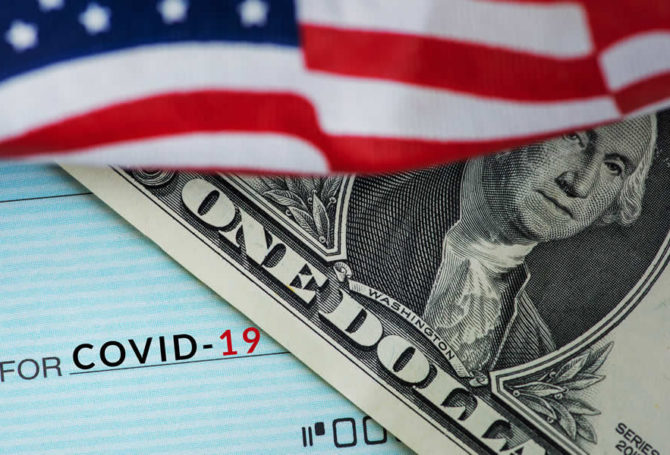
The $1.9 trillion American Rescue Plan moving through Congress bears a Pacific Northwest stamp and contains health care and childcare provisions that promise relief far past the end of the pandemic. It would be the largest financial relief package in US history.
After a marathon 25-hour floor debate over the weekend, the Senate approved the relief package on a partisan vote. The House will take up the amended version of the package on Tuesday, where it is expected to pass also on a largely partisan vote.
Revenue-sharing counties
Oregon Senator Ron Wyden inserted a two-year, $2 billion provision into the broader financial relief measure that extends federal payments to Oregon counties with large amounts of tax-exempt public lands administered by the US Forest Service and the Bureau of Land Management.
Wyden’s provision directs the Department of Treasury to develop a new formula that takes into account economic conditions in revenue-sharing counties with the goal of stabilizing local economies that suffer frequent boom-to-bust cycles and uncertain federal payments. A quarter of the $2 billion will go into a similar economic stabilization fund for eligible tribal governments.
Restaurant and bar federal grants
The Senate retained a House provision authored by Oregon Congressman Earl Blumenauer that allocates $25 billion to provide federal grants to restaurants and bars forced to close during the pandemic. Non-publicly trade restaurant groups would be eligible for a maximum $10 million grant and individual restaurants could receive up to $5 million. Grants could be spent on payroll and benefits, rent, utilities, maintenance, supplies, food and beverages and other operational expenses.

Eligible businesses include bars, restaurants, caterers, breweries, taprooms and tasting rooms. Grant amounts would be calculated after subtracting any previous Payroll Protection Plan loans. Establishments that have applied for the Shuttered Venue Operators grant program would be ineligible.
While news coverage has focused on direct stimulus payments and extension of enhanced unemployment benefits, the American Rescue Plan contains numerous far-reaching provisions that address health care issues and childcare gaps that surfaced during the pandemic.
Health care provisions
There are 15 separate health care provisions totaling $176 billion that increase spending on mental health services and community health centers, enhance Medicaid funding, provide grants for rural emergency health care and raise funding for veteran’s care, Indian Health Services and skilled nursing facilities. Substantial sums are reserved for purchasing, distributing and administering COVID-19 vaccines and to sustain testing, contact tracing and other mitigation strategies.
A largely overlooked provision allows employees who have been laid off or furloughed to remain eligible for employer-based health care coverage through September. Employees would be required to pay only 15 percent of the premiums and employers would be eligible for a refundable tax credit.
A largely overlooked provision allows employees who have been laid off or furloughed to remain eligible for employer-based health care coverage through September. Employees would be required to pay only 15 percent of the premiums and employers would be eligible for a refundable tax credit.
Affordable Care Act exchanges would get a boost in funding and federal employees who contract the coronavirus before January 30, 2023 would have their illness presumed work-related for workers’ compensation benefits. More than $7 billion is set aside to fund public health workforce and mental health training.
Far-reaching childcare benefits
News reports have featured the $178 billion in the package to support reopening of public schools and colleges. There has been attention to childcare provisions totaling $219 billion, which expand the social safety net and may have the most longstanding impact. The American Rescue Plan increases the existing Child Tax Credit and Earned Income Tax Credit designed to help low-income families and young adults. Provisions raise the maximum benefit most families will receive by 80 percent and extend coverage to families that now don’t earn enough to qualify.
Advocates say the enhancements, which will include families receiving monthly checks of up to $300, could cut child poverty in half and, if made permanent by subsequent legislation, yield multi-generational positive effects. Critics warn these enhancements amount to welfare and could discourage people from returning to work. Recent statistics indicate 2 million American women have exited the US workforce. There also are fears that many low-paying service-sector jobs that were lost during the pandemic economic lockdown may never return as retail patterns have changed and employers have automated more processes.
Opposition to the childcare provisions has been relatively muted, as political conservatives see value in monetary benefits that aren’t restricted such as food stamps. Utah Senator Mitch Romney has proposed more expansive childcare benefits, though his plan would pay for those benefits with cuts to other programs.
Better known plan provisions
The best-known provisions include $424 billion for $1,400 direct stimulus payments that will go to middle and low-income people, which are intended to tide over households until the economy opens up more fully and also give the economy an immediate jolt through increased consumer spending.
Enhanced federal jobless benefits will continue at $300 per month until September 5, at a cost of $246 billion. The benefits approved in an earlier coronavirus relief bill, will expire this month, which was the reason President Biden and congressional Democrats pushed for rapid approval of the American Rescue Plan.
Aid to state and local governments, aimed at preventing service cuts that put a drag on broader economic recovery, totals $350 billion. Some $109 billion is included to aid farmers and small businesses, $47 billion for disaster relief and $40 billion for renters and homeowners to avoid eviction and foreclosure.




